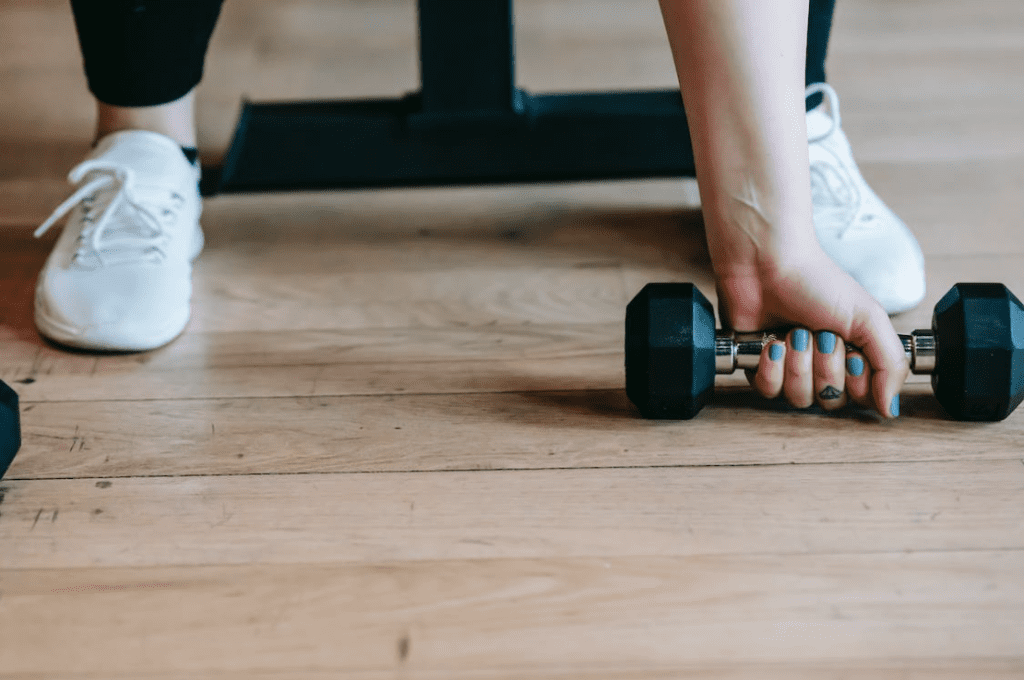
If you want to get into weightlifting but are confused on where to start, look no further!
When you’re trying to create a weightlifting routine for yourself, things can seem confusing and overwhelming. Especially at first.
If this sounds like you, then this post is for you. Instead of giving you essential tips to start a workout routine, I’m going to walk you through exactly what you need to do to start one.
In this post, I’ll show you all the basics so you can learn exactly what you need to do to start a weightlifting routine.
After reading this post, you’ll be able to create the perfect routine for yourself. Then, you’ll be seeing results in no time!
In this post you’ll find:
Why it’s important to have a weightlifting routine
The main benefit of a weightlifting routine, or any kind of workout routine for that matter, is that it helps give your workouts structure.
It’ll help you know how to structure each workout as well as each week. With this, you’ll never get to the gym feeling confused or not having a plan for the day ever again.
Traditionally, a workout routine is a weekly basis type of thing. Meaning you make your routine for one week, then you keep repeating that routine weekly.
You do this until it’s time to change up your workout routine.
As a result, your workout routine also helps you plan your workouts for the week. By doing this, you’ll always be going to the gym with a plan, and every week will be designed to help you reach your goals.
Keep in mind your routine will be different than someone else’s
When you’re trying to start a workout routine, it can be hard finding consistent information on how you should start and structure your routine. Don’t worry though, this isn’t your fault.
Instead, the main reason for this is that everyone has different goals they want to achieve from their workouts.
Because of this, everyone’s routine is going to and should look different!
Think about it, someone who’s training to run a marathon won’t have the same workout routine as a bodybuilder. Of course, those are more to the extremes, but the same idea goes for us regular people.
You’ll have different goals than the person next to you and they’ll have different goals than you. And since our workout routine will directly reflect our goals, it makes sense that we’d all have a different routine.
It’s important to keep in mind that everyone has different goals, and everyone’s body reacts different to each exercise.
As a result, it’s important to about finding what works for you!
Here’s exactly what you need to do to start your weightlifting routine
Now that we’ve covered all the basics, we can get into the steps you can follow to create a weightlifting routine for yourself.

Establish your goals
The first thing you need to do to start creating a workout routine is establish your goals.
It’s important to ask yourself what you want to get from your workouts as well as what you want to accomplish from your routine.
For example, is your goal to lose weight? Or maybe lose fat? Body recomp? Improve your mental health? Etc. etc.
There are so many benefits to working out and weightlifting. That’s why it’s so important that you establish what benefits and results you hope to achieve for yourself.
Once you establish your goals, you can use them as a guide for yourself and how you should workout.
By doing this, it’ll become much more clear to yourself on how you should structure your routine.
Additionally, not everyone works out for the same reason and wants the same results.
It’s crucial to establish your goals for yourself beforehand so right from the start you can personalize your routine to fit your own, personal goals.
Determine how many days a week you want to (or are able to) workout
It’s important to realize that everyone’s lives and schedules are different.
As a result, everyone will have a different amount of time they want to workout each day. Depending on what works best for them.
The more often you lift weights, the bigger part of your life it becomes. Meaning the more time you allocate to working out, the less time you’ll have for other things.
This might not be a bad thing. I love working out so much that it’s worth it to me to sacrifice some of my free time for my workouts.
However, the same thing might not apply to everyone.
It’s important to determine how much time each day and each week you want to allocate to working out.
It’d be extremely hard to make a routine for yourself without knowing how many days a week you actually want to be in the gym.
That’s why deciding on this should be one of your first steps when creating your routine.
Generally, the sweet spot is to lift 4-5 times a week to see the best results. But again, it’s personal to everyone and everyone has their own preferences.
Maybe it’s not how often you want to workout, but how often you can workout
On top of that, not everyone has enough free time and is able to workout as much and as often as they’d like.
It’s important to figure out how much time you actually can allocate to working out each week.
Not only that, but it’s important to be realistic with this time as well.
If you’re someone who’s super busy with work and school, don’t try and create a routine that requires you to be lifting weights for 3 hours a day.
This would be extremely unrealistic and likely unattainable.
Instead, be realistic with yourself and try and create a routine that you can actually achieve.
Create a routine that you can strive to follow without adding additional stress to your life.
Determine what muscles you want to grow
Determining what muscles you want to grow is an important part of creating a lifting routine for yourself.
My recommendation would be to train muscles you want to maintain once a week. Whereas muscles you want to grow twice a week.
I wouldn’t recommend training muscles you want to grow more than twice a week. Even though it seems like training more would help you grow more, this isn’t necessarily true past a certain point.
Once you start training too much to the point where your muscles can’t rest, you actually start preventing growth.
That’s why it’s important not to overdue it when it comes to training. Even though it’s tempting and might seem like it will give you more progress.
Now, based on your goals and what you want to grow, use that to determine your split.
Let’s say from the previous step you had determined you want to lift 4 days a week.
Let’s also say you’ve decided you want to grow your legs and shoulders. However maintain your arms, back, and chest.
That would mean you would need two leg days, two days for back, two days for shoulders, and one day for arms. Determining this is the biggest step to start planning your split.
See how I’m starting with the goals, then from there using that to determine how to start planning the workouts?
Based on all of this, your split might look something like this:
Monday – Back and shoulders
Tuesday – legs
Wednesday – rest
Thursday – arms, shoulders, and chest
Friday – legs
See the idea here? The muscles you want to grow you’d train twice a week. Whereas the ones you want to maintain without growing you’d train only once a week.
Do enough (but not too many) exercises per workout
Now that you know when you want to workout and what you want to do each day, you need to determine how to structure each workout session.
The main things that makes up each workout session are the exercises you do.
It’s important to make sure you’re doing enough exercises per session in order to stimulate growth.
As well as make sure you’re not doing too many exercises per workout.
Although it’s not really possible to do too many exercises, it is possible to get the point in your workout where you’ll be too fatigued to do any more exercises effectively.
At this point, you probably won’t get much benefit from doing more exercises beyond that.
However, it’s unlikely that doing more exercises would harm your gains in anyway. But personally, I would rather not do more exercises than I have to.
In the end, it all just depends on how you want to work out.
How many exercises should you actually do?
For each lifting session, I would recommend doing at least two exercises per muscle group you’re training.
Additionally, I wouldn’t recommend doing more than 4 or 5 per muscle group. It depends on how intense and demanding each exercise is, but I would say generally more than 4 or 5 isn’t necessary.
This means if you’re training two muscle groups at once, the sweet spot for growth would be between 4 and 8 exercises for your workout.
Implement enough rest days
The final factor that you need to complete your workout routine is rest. Rest days are going to be critical for you to implement into your workout routine.
Why rest is CRITICAL
Rest is extremely important for women who lift weights. This is because rest is essential for your muscles to grow.
When you workout and lift weights, you make a ton of tiny tears in your muscles. The only way these tears can repair is by getting rest.
Not only that, but when your muscles repair themselves, they repair themselves bigger than before. This means that through the repair process is when you’re muscles grow.
So essentially, working out is an endless cycle of slightly damaging your muscles during your lift, then allowing them to rest, repair, and grow. Without enough rest, you won’t see enough growth.
How much rest should you be getting?
It’s important to allow your muscles at least 48 hours between training sessions. This doesn’t mean once you workout you have to wait 48 hours before working out again though.
Instead, what it means is that once you train a specific muscle group, you should wait 48 hours before training that specific muscle again.
For example, let’s say you train back on Monday. That means you should wait until at least Wednesday to train back again, if not longer.
Additionally, you should never train a muscle when it’s sore. Keeping this in mind, you might need to adjust and reevaluate your routine if a muscle group is sore when you’re supposed to be training it.
Finally, on top of waiting 48 hours between training each muscle, I’d also recommend giving your body at least 1 to 2 full rest days a week.
Depending on how hard you’re training, you might need more or less. But I would say no matter how intensely you train, everyone who lifts weights should be taking a full day or two completely off, per week.
Takeaways
Creating a workout routine, whether it be from scratch or revising an old one you had, can seem overwhelming.
But don’t worry! It’s not as complicated as you might think.
By breaking down your goals and following these steps, you can create a routine that’s realistic for yourself and personalized to you and your goals.
By doing this, you’ll have a weightlifting routine that’ll keep you organized and on track in the gym.
Then, you’ll be seeing results in no time!
More posts on women’s weightlifting:
Unilateral movements and why they’re essential in the gym